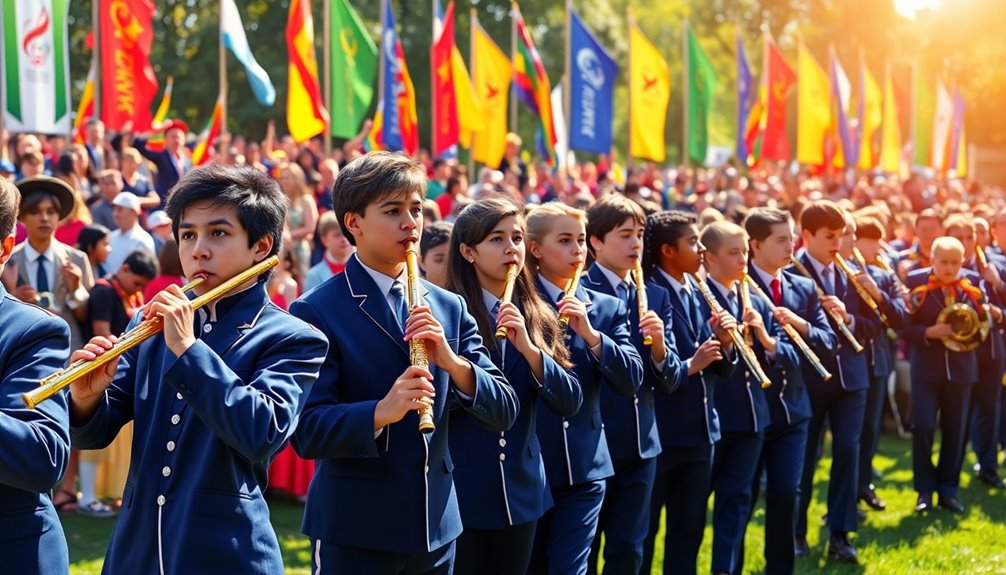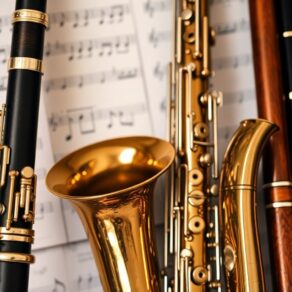If you want to energize your school flute performances, consider exploring a variety of exciting music styles! Immerse yourself in classical pieces from Bach and Mozart for timeless elegance, or jazz improvisation for creative expression. Folk favorites invite audience participation, while contemporary pop tunes bring fresh energy. Don't overlook world music for rich cultural storytelling, and traditional marching music for a spirited, rhythmic experience. Seasonal songs can evoke nostalgia, and Baroque repertoire challenges your technical skills beautifully. Each style offers unique opportunities for engagement and creativity, making your performance memorable. Keep going, and you'll uncover even more musical avenues to explore!
Key Takeaways
- Classical Selections: Incorporate timeless masterpieces by composers like Bach and Mozart to showcase flute beauty and engage audiences with rich, expressive music.
- Jazz Flute Improvisation: Encourage students to experiment with jazz phrasing, rhythms, and dynamics, fostering creativity and comfort with improvisation.
- Folk Music Favorites: Utilize traditional folk songs that tell stories and encourage audience participation, enhancing emotional expression and community connection.
- Contemporary Pop Tunes: Feature catchy melodies from popular artists like Billie Eilish and Taylor Swift, promoting joy and energetic engagement among students and audiences.
- World Music Influences: Integrate global styles and rhythms into performances, enriching the musical experience and fostering collaboration with local musicians.
Classical Music Selections

When you think of classical music, the image of a grand concert hall often comes to mind, but it can also be a perfect choice for school flute performances.
Classical music offers a rich repertoire that showcases the beauty of the flute, allowing students to explore their skills while connecting with timeless masterpieces. It's a wonderful way to express yourself and find your place within a larger musical tradition.
Choosing pieces by famous composers like Bach, Mozart, or Vivaldi not only enhances your performance but also deepens your appreciation for the art form. Each composer has a unique style, and understanding these differences can help you develop your flute techniques.
For instance, Vivaldi's lively rhythms can encourage you to master articulation, while Mozart's lyrical melodies invite you to focus on breath control and phrasing.
Don't underestimate the power of classical music to foster a sense of belonging. When you perform these works, you're joining a long lineage of musicians who've expressed their emotions and stories through their instruments.
Your peers and audience will connect with the music, creating a shared experience that transcends individual performances. Additionally, selecting pieces that align with your skill level appropriateness ensures that you can engage with the music effectively and enjoyably.
Jazz Flute Improvisation

Although some may view jazz as a complex genre, diving into jazz flute improvisation can be an exhilarating experience for any student musician. The beauty of jazz lies in its spontaneity, allowing you to express yourself in ways that classical music may not.
To start, familiarize yourself with essential flute techniques. Focus on scales, arpeggios, and breath control, as these will serve as your foundation for improvisation.
When you're ready to improvise, remember a few key improvisation tips. First, listen to jazz recordings and pay attention to how other musicians phrase their solos. This will help you develop your own unique sound.
Don't be afraid to experiment with rhythms and dynamics; jazz thrives on creativity!
As you practice, try playing along with a backing track. This can help you get comfortable with the structure of a piece while still giving you room to explore your musical ideas. Start with simpler melodies and gradually challenge yourself with more complex changes.
Above all, embrace the mistakes you make along the way. They're part of your learning process and can lead to unexpected, beautiful moments in your playing. Additionally, engaging with online communities for feedback can enhance your improvisation skills and provide support from fellow musicians.
Remember, jazz is about dialogue—so interact with your fellow musicians and let the music flow! With time and dedication, you'll not only improve your flute techniques but also find a vibrant community that celebrates your artistic journey.
Folk Music Favorites

Folk music offers a rich tapestry of melodies and stories that can captivate both performers and audiences alike. When you play traditional folk tunes on your flute, you're not just performing; you're sharing history and culture. This music often incorporates folk instruments like the guitar, fiddle, and banjo, creating a vibrant soundscape that resonates with listeners.
Here are a few reasons to embrace folk music in your performances:
- Cultural Connection: Folk music can connect you to different cultures and communities.
- Storytelling: Each song tells a story, allowing you to engage your audience on a deeper level.
- Group Participation: Folk music often encourages audience sing-alongs, making everyone feel included.
As a flutist, you can explore a variety of traditional folk pieces, from Appalachian ballads to Irish jigs. These melodies are often simple yet powerful, allowing you to focus on expression and emotion. Additionally, incorporating ornamentation techniques can enhance your performance, adding richness and authenticity to the melodies.
You can even experiment with improvisation, adding your personal touch to these timeless tunes.
Contemporary Pop Tunes

Contemporary pop tunes bring a fresh and dynamic energy to school flute performances, enchanting audiences with their catchy melodies and relatable themes. These songs are often at the forefront of viral trends, making them instantly recognizable and appealing to your peers. When you choose a popular song, you're tapping into a cultural moment that resonates with everyone.
One of the great things about contemporary pop is the variety of catchy hooks that capture listeners' attention right from the start. Think about the songs you and your friends can't help but sing along to. Incorporating these hooks into your flute performance not only showcases your skills but also creates a sense of camaraderie among your audience. They'll feel included as they recognize and engage with the music.
When selecting tunes, aim for pieces that are fun and energetic. Songs by artists like Billie Eilish, Taylor Swift, or Ed Sheeran often have that perfect blend of melody and emotion. You can even explore arrangements that allow for improvisation, adding a personal touch to well-loved tracks. Engaging accompaniments enhance the performance experience and can motivate you to practice more effectively as you develop your skills with rock flute sheet music selections.
Your performance can inspire and uplift, making everyone feel connected through music. Don't shy away from experimenting with different styles and arrangements.
Whether you're playing solo or with friends, contemporary pop tunes can make your flute performance the highlight of the event, ensuring that everyone leaves feeling joyful and connected. So grab your flute, and let those catchy tunes shine!
World Music Influences

Exploring world music influences can add a rich tapestry of sound and rhythm to your school flute performances. By incorporating diverse cultural elements, you not only engage your audience but also celebrate various traditions and histories.
Here are some exciting ways to bring global melodies and cultural rhythms into your music:
- Integrate traditional folk songs: These pieces often tell stories that connect audiences to different cultures.
- Experiment with unique scales: Many cultures use alternative scales that can create enchanting and unexpected sounds on your flute.
- Incorporate rhythmic patterns: Adding percussion elements or clapping can enhance the cultural feel of your performance.
When you blend these world music influences into your repertoire, you create a vibrant experience that resonates with everyone.
Think about the rich sounds of African drumming, the intricate melodies of Indian classical music, or the lively tunes of Latin American folk. Each style brings its own set of cultural rhythms, inviting your listeners to journey through sound.
Don't hesitate to collaborate with classmates or local musicians who specialize in these genres. This not only enriches your performance but fosters a sense of community. Additionally, selecting pieces that reflect cultural authenticity and context can further enhance your audience's appreciation of the music.
Exploring world music together can deepen your connection with each other and your audience. So, embrace the diverse sounds around you, and let your flute take flight across borders, creating a performance that's not just entertaining but also meaningful.
Your school performances can become a celebration of the world's musical heritage!
Movie Soundtrack Pieces

While you might think of movie soundtracks as just background music, they actually offer a fantastic opportunity to showcase your flute skills in an enchanting way. These pieces often feature iconic themes that are instantly recognizable, inviting your audience to connect emotionally with the performance. Imagine playing the sweeping melodies from beloved films like "Star Wars" or "Harry Potter." Not only will you captivate your listeners, but you'll also feel a sense of belonging as you share these familiar tunes.
Many movie soundtracks are crafted with orchestral arrangements that allow flutes to shine brightly. The combination of strings, brass, and percussion creates a lush backdrop that enhances your flute's voice, making it a perfect choice for school performances. You'll find that playing these pieces can boost your confidence, as they often evoke strong feelings of nostalgia and excitement in your audience. Additionally, incorporating popular Broadway melodies from the flute repertoire can further enrich your performance and connect with diverse musical traditions.
To get started, consider selecting a few pieces that resonate with you or your peers. Whether it's the ethereal sounds of "The Lion King" or the adventurous scores from "Pirates of the Caribbean," there's a wealth of material to choose from.
You'll not only improve your technical skills but also foster connections with fellow musicians and listeners who share your love for film music.
Traditional Marching Music

If you've enjoyed the emotional connections of movie soundtracks, you'll find that traditional marching music brings a different kind of energy to your flute performances. Marching band music is all about precision, camaraderie, and vibrant rhythmic patterns that can invigorate your playing.
It's not just about hitting the right notes; it's about creating a unified sound that resonates with both performers and the audience.
Here are a few key elements that make traditional marching music special:
- Strong, Driving Beats: The rhythms propel the music forward, inviting your audience to tap their feet along.
- Engaging Melodies: These tunes often have catchy, memorable lines that stick with listeners long after the performance.
- Team Spirit: Playing in a marching band fosters a sense of belonging and teamwork, as everyone works together to create a cohesive sound.
As you explore traditional marching music, you'll notice how the distinct rhythmic patterns can challenge and enhance your flute skills. It encourages discipline and timing, essential components of any musician's journey. Plus, it's an excellent way to connect with your fellow bandmates, building relationships that can last a lifetime. Joining an ensemble not only enriches your musical experience but also fosters personal growth and teamwork.
Baroque Flute Repertoire

The Baroque flute repertoire is a treasure trove of expressive music that showcases the instrument's rich timbre and versatility. If you're looking to elevate your school performances, diving into this genre can offer you a unique and rewarding experience.
Baroque sonatas and concertos not only challenge your technical skills but also allow you to connect with the emotional depth of the music.
One of the most exciting aspects of Baroque music is its intricate interplay between the flute and other instruments. When you explore pieces like Bach's Flute Sonata in E Major or Vivaldi's Flute Concerto in D Major, you'll find yourself immersed in the lively dialogue between melodic lines and harmonies.
These works highlight the flute's agility and expressive capabilities, making them perfect for showcasing your talent.
As you prepare for performances, remember that studying Baroque music isn't just about mastering the notes. It's about understanding the style and the historical context that shapes it. Additionally, engaging with this repertoire can foster a sense of community among your peers, as you share interpretations and insights.
New Age Flute Compositions

New Age flute compositions offer a fresh and enchanting way to enhance your school performances, blending elements of classical music with contemporary influences. These pieces create a unique atmosphere that captivates audiences, inviting them into a world of meditative soundscapes and ambient textures.
By incorporating New Age music into your repertoire, you'll not only showcase your flute skills but also foster a sense of connection and serenity among your listeners.
Here are some key aspects to reflect on when exploring New Age flute compositions:
- Versatile Styles: New Age music encompasses a wide range of styles, allowing you to select pieces that resonate with your personal expression.
- Emotional Depth: These compositions often evoke deep emotions, making your performance memorable and impactful.
- Collaborative Opportunities: New Age music frequently involves collaboration with other instruments, providing a fantastic chance to work alongside your peers.
When you choose New Age pieces, you'll notice how they encourage creativity and experimentation. Your flute can create enchanting melodies that transport listeners to serene landscapes, offering an escape from everyday life. Additionally, integrating traditional flute melodies can further enrich your performance, allowing you to connect deeper with cultural roots.
Whether you're playing solo or alongside others, these compositions can transform your performance into a shared experience, fostering a sense of belonging among your audience.
Embrace the ethereal qualities of New Age flute music, and watch as your school performances become a celebration of artistry and connection!
Seasonal and Holiday Songs

What better way to celebrate the spirit of the seasons than through seasonal and holiday songs for flute performances? These melodies not only warm the heart, but they also create a sense of community among performers and audiences alike. Whether you're preparing for a winter concert or a festive gathering, incorporating winter classics and festive arrangements can elevate your performance and bring joy to everyone.
Here's a quick guide to some popular seasonal songs you might consider:
| Season | Song Example |
|---|---|
| Winter | "Jingle Bells" |
| Spring | "Here Comes Peter Cottontail" |
| Holiday | "Ode to Joy" |
Playing these tunes can help you connect with your audience and evoke feelings of nostalgia and celebration. Imagine the smiles on faces as you perform a lively rendition of "Jingle Bells" or a serene interpretation of "Ode to Joy." Additionally, many of these songs are included in Disney songs suitable for all ages, providing an engaging and memorable experience for both players and listeners.
As you explore these songs, don't hesitate to add your personal touch. Whether it's a unique arrangement or a creative shift, your individuality will shine through in your performance. Remember, music is a shared experience, and your passion for seasonal and holiday songs can truly resonate with others. So grab your flute, choose your favorites, and let the festive spirit fill the air!
Frequently Asked Questions
What Are Some Tips for Choosing the Right Flute for Performances?
When you're choosing the right flute for performances, consider the different flute types available, like student, intermediate, and professional models.
Keep your budget in mind—there are great options for student budgets that won't sacrifice quality.
Test out a few flutes to see which feels comfortable and produces the sound you love.
How Can I Improve My Flute Playing Skills Quickly?
Did you know that regular practice can improve your skills by up to 30% in just a few weeks?
To boost your flute playing, focus on specific flute techniques like tonguing and scales. Create a consistent practice routine, dedicating time each day to warm-ups and challenging pieces.
Join a group or find a buddy to share your progress with, as this sense of belonging can motivate you to push your limits and enjoy the journey!
What Should I Wear During a Flute Performance?
When you're preparing for a flute performance, your performance attire is key to enhancing your stage presence.
Choose something that makes you feel confident and comfortable—like a nice dress or tailored outfit. Avoid overly flashy clothes that might distract from your music.
Remember, your outfit should reflect your personality while keeping the audience focused on your playing.
With the right attire, you'll feel more connected to your performance and your audience!
How Do I Handle Performance Anxiety on Stage?
Performance anxiety can feel like a storm brewing inside you. To calm those turbulent waves, practice breathing techniques—like deep, slow breaths—before you step on stage.
Visualize yourself in a peaceful setting, playing effortlessly, and focus on the joy of sharing your music.
Remember, everyone feels nervous sometimes, and it's okay. Embrace the moment, and let your passion shine through.
You've got this—your music deserves to be heard!
Are There Specific Warm-Up Exercises for Flute Players Before Performances?
Before your performance, warming up is essential. Start with long tone exercises; they'll help you focus on your breath and tone quality.
Slowly play through your scales, paying attention to intonation and dynamics. This practice not only builds your confidence but also prepares your fingers and mind for the music ahead.
Conclusion
Incorporating these diverse music styles into your school flute performances can truly elevate your playing and captivate your audience. Whether you're jamming like a rock star with contemporary pop tunes or gracefully maneuvering through the intricate melodies of Baroque pieces, there's something for every flutist. Embrace the excitement of blending genres and exploring new sounds, just like Mozart would've done with a modern twist. So, grab your flute and let your creativity soar—your next performance is bound to be unforgettable!






